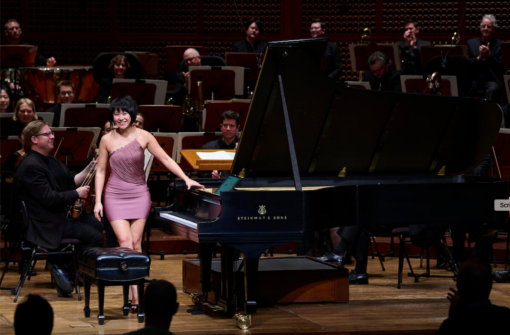 United States Ravel, Rautavaara, Debussy: Yuja Wang (piano), San Francisco Symphony / Esa-Pekka Salonen (conductor). Davies Symphony Hall, San Francisco, 13.2.2025. (HS)
United States Ravel, Rautavaara, Debussy: Yuja Wang (piano), San Francisco Symphony / Esa-Pekka Salonen (conductor). Davies Symphony Hall, San Francisco, 13.2.2025. (HS)

Ravel – Piano Concerto for the Left Hand
Rautavaara – Piano Concerto No.1
Debussy – Gigues, Rondes de printemps, Ibéria
Pianist Yuja Wang is no stranger to the San Francisco Symphony. Her annual appearances with the orchestra and in recital under the company’s presence have been something to look forward to for years. Aside from this week’s subscription concerts exploring concertos by Maurice Ravel and Einojuhani Rautavaara with conductor Esa-Pekka Salonen, she is back next month for a duo recital with pianist Víkingur Ólafsson.
The two concertos on this program, seen and heard by a near-capacity audience, stretched the boundaries for both composers. The challenge for the early-twentieth-century Ravel was to discover a way to make a one-handed pianist sound like anyone else, not an easy task for a composer who specialized in creating dense harmonies. For Rautavaara, the late-twentieth-century Finnish composer, the challenge was to show off his own prowess on the piano but to do it within the limits of the brashly dissonant, serial-influenced music that was de rigueur for the day.
Ravel’s Piano Concerto for the Left Hand was written for Paul Wittgenstein, a Vienna-born pianist who lost his right arm in a harrowing World War I encounter in Poland in 1914. It is by far the best-known work by the many composers who answered Wittgenstein’s request for music he could play, a list that included Britten, Hindemith, Korngold, Prokofiev and Richard Strauss.
It is a barn-burner that ingeniously employs updated versions of J. S. Bach’s techniques for making a single violin or cello sound like several by breaking up the melodic lines and overlapping them. It is impressive enough on a string instrument, where it is a matter of centimeters between strings or fingerings. On a piano, the quick jumps between several octaves require an athletic approach that is easily seen.

Wang made it look, well, not exactly easy but almost effortless, and it made for great visuals as she found balance by grasping the side of the piano bench or the frame next to the keyboard. She executed the long sprays of harmonic coloratura with precision, and the extra effort produced beautifully natural music. With crisp conducting from Salonen, the juicy fanfares and rhythms from the orchestra fit nicely, even when the orchestra got a little too enthusiastic in the opening portion of a single-movement, twenty-minute concerto.
The middle section, in which Ravel tried to capture a soft jazz rhythm, brought things to a mesmerizing unity between pianist and orchestra. The piece finished with bravura playing all around.
Rautavaara’s Piano Concerto No.1 debuted in 1969, while he was still making music of harsh dissonances and sardonic references. A more Romantic style became evident in most of Rautavaara’s eight symphonies and concertos for a wide variety of instruments by the time he was one of Salonen’s teachers at the Sibelius Academy, in the 1970s.
The Rautavaara concerto delivered plenty of whiz-bang technical playing, opening with a gush of ecstatic fanfares followed by an extravagant opening gambit of extended pianistic flourishes. Under Wang’s hands, the thorny harmonics in the first movement, which was marked Con grandezza, turned to something softer in the second movement Andante (ma rubato). Its plush chord sequences on the piano wove through a tamer background in the orchestra, and Wang coaxed all the warmth she could out of that section.
In the finale, bravura glissandos raced up and down the keyboard, and Wang managed to make chord clusters hammered with the left forearm make sense by somehow magically fashioning a coherent melody every time.
There were two encores, both dating from the 1990s, which spun some of the exploratory energy of the two concertos in different directions. The first was Philip Glass’s Étude No.6, a feast of harmonic elaborations. Wang made it celebrate the florid possibilities of the piano and, at times, it had me thinking of Rachmaninoff and of the jazz giant Bill Evans.
The second encore, even more exciting, was Mexican composer Arturo Márquez’s Danzon No.2 (transcribed by Leticia Gómez-Tagle in 2016). It seemed to echo the jazzy middle section of the Ravel concerto, relishing offbeat syncopations and the slithery up-tempo style of Cuban rhythms and tango. Salonen was on hand to turn pages (actually to tap the score on the iPad screen). He fumbled at one point, but Wang didn’t miss a beat.
As always, Wang made extra impact with her fashion flair. For the Ravel, she wore a striking, form-fitting, deep-blue gown with a dazzling tangle of sinewy straps at the top, a long slit at the side and a dramatic train, accented with Labouton stiletto shoes. For the Rautavaara it was a mauve minidress, tight-fitting, with diagonal rouching on the asymmetrical top.
Bracketing the concertos were three pieces by Ravel’s fellow French impressionist, Claude Debussy. All were from his Images pour orchestre project, composed between 1905 and 1912. Played with only a brief pause between them, Gigues launched the program and felt a bit hesitant, but Rondes de printemps painted a charmingly decorative picture of spring emerging.
Ibéria finished the program with chimes, tambourines and castanets providing percussion color, and all made it through Debussy’s sketches of Spain without problems. It was pleasant enough, but it definitely was outpunched by the concertos.
Harvey Steiman

It is wonderful to read this beautifully worded review. It gives me much to think about.